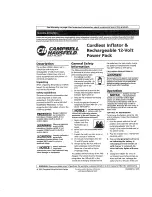
6
If this is not practical, keep the work
area well ventilated. Open all windows.
Place an exhaust fan in one window,
making sure it is moving the air from
inside the work area to the outdoors.
2. Remove all cooking utensils and
food from the work area.
3. Remove all carpets, rugs and
furniture from the work area where
practical. If removal is not practical,
move furniture to the middle of the
room and cover them with a plastic
drop cloth.
4. Seal off work areas from the rest of
the dwelling by sealing off doorways
with drop cloths.
5. Cover all air ducts.
6. Place a drop cloth in the work area
to catch paint chips or peelings.
7. Wear protective clothing to reduce
the amount of exposed skin.
8. Children, pregnant or potentially
pregnant women and nursing mothers
should not be present in the work area
until the work and cleanup have been
completed.
9. Use a respirator mask for dust and
fumes which has been approved by
“OSHA” or “NIOSH”. These masks
and replaceable filters are available
at most major hardware stores. Make
sure the mask fits properly. Beards
and facial hair may prevent the mask
from fitting properly. Change filters
often. Disposable paper dust masks
are NOT adequate for protecting
against inhaling lead fumes.
10. Keep the Heat Gun moving while
heating the paint. Excessive heat will
generate increased amounts of fumes
which can be inhaled by the operator.
11. Keep food and drinks out of the
work area. Always wash hands,
arms and face and rinse mouth with
water before eating or drinking. Never
smoke or chew gum or tobacco in the
work area.
12. When the paint stripping operation
is completed, clean up all removed
paint and dust by wet mopping the
floors. Do NOT sweep or vacuum
dusty areas. Use a solution of
trisodium phosphate (TSP) in water to
wet mop the floors and clean all walls,
sills and any other surface where paint
dust has settled.
13. Use protective gloves to protect
your hands from burns.
14. Use extreme caution if the
opposite side of the work surface
such as siding is not accessible.
The hidden side could catch fire if
it becomes too hot. Some buildings
contain flammable material behind the
siding, floors, fascia, soffit boards and
other such panels. Check these areas
before applying heat. Do not use the
Heat Gun if flammable materials are
present or if you are unsure of the
flammability of the hidden material.
15. Do not use the Heat Gun near
surfaces with cracks or near metal
pipes, flashings, etc. Heat may be
conducted behind the work surface
and ignite hidden material. The ignition
of hidden material may not be readily
apparent and can cause property
damage and injury.
Summary of Contents for PRO-PC1200
Page 1: ...Heat Gun User s Manual Model No PRO PC1200 English 2 I Espa ol 14...
Page 14: ...NOTES...
Page 15: ...NOTES...
Page 16: ...www promakertools com...
Page 17: ...Pistola de Calor Manual del Usuario Modelo No PRO PC1200...
Page 31: ...NOTAS...
Page 32: ...www promakertools com...







































